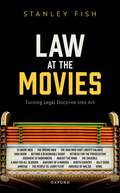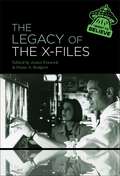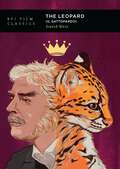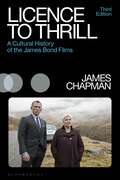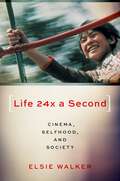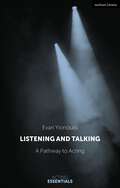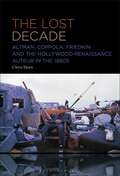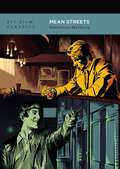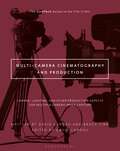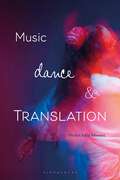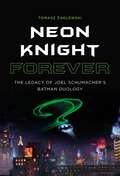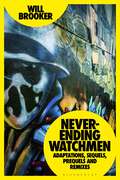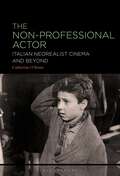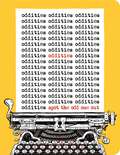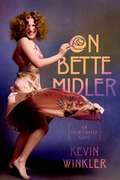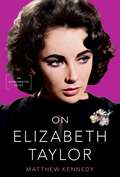- Table View
- List View
Law at the Movies: Making Change in the Networked Public Sphere (Law and Literature)
by Thomas J BillardTransgender rights have emerged as an important topic of everyday conversation across the country in recent years and become, in many ways, the flashpoint du jour of the American culture wars. During the Trump presidency in particular, transgender people were thrust onto the center stage of US politics. Faced with unrelenting hostility and an increasingly complicated media system, transgender activists crafted new communication strategies to fight for their equality, stall attempts to undermine their rights, and win the support of large swathes of the public. In Voices for Transgender Equality, Thomas J Billard offers an insider's view into transgender activism during the first two years of the Trump administration. Drawing on extensive on-the-ground observation at the National Center for Transgender Equality, Billard shows how these activists developed an unlikely blend of online and offline strategies to saturate a diverse ecology of national news outlets, local and community media outlets across the country, and both public and private conversations across multiple social media platforms with voices in support of their cause. Moreover, these activists navigated the complex flows of information and ideas among these different domains of the communication system as they worked to shape the national conversation on transgender rights. As Billard argues, this movement occurred at a very particular time in the development of the media system, with "new" media shaping the movement in important ways that are both generalizable to other social movements and unique to transgender activism. Including rich storytelling and insightful analysis, Voices for Transgender Equality makes a compelling case of what it takes to make social and political change in a world transformed by digital media. Along the way, Billard provides key insights into the new business-as-usual of mediated politics and valuable lessons for more effective activism.
Law at the Movies: Turning Legal Doctrine into Art (Law and Literature)
by Prof Stanley FishThis book asks "How can legal doctrine be turned into filmic art?" By "legal doctrine" Stanley Fish does not mean the sonorous abstractions that usually accompany the self-presentation of law--Justice, Equity, Equality, Liberty, Autonomy, and the like. Rather he has in mind the specific rules and procedures invoked and analyzed by courts on the way to declaring a decision--lawyer/client confidentiality, the distinction between interdicted violence and the violence performed by the legal system, the interplay of positive law and laws rooted in morality, the difference between civilian law and military law, the death penalty, the admissibility of different forms of evidence. In the movies he discusses, these and other points of doctrine and procedure do not serve as a background, occasionally visited, to the substantive issues that drive the plot and provide the characters with choices; they declare the plot, and character is formed and tested in relationship to their demands. Apparently technical matters are pressed until they occupy both foreground and background and become the movie's true subject. If large, abstract concepts emerge, they emerge at the back end of doctrine and are, in effect, produced by doctrine. These are not law-themed movies; they are movies about the unfolding of legal process.
The Legacy of The X-Files
The Legacy of The X-Files examines the content and production of the show, its reception, its use of legend and folklore, its contemporary resonance in politics and society of the 21st century, and its impact and legacy on film, television, the Internet and beyond. Having converged with the early widespread use of the Internet, The X-Files became a cultural touchstone of the 1990s, transforming from a cult TV show into a pop cultural phenomenon by the end of the decade. To celebrate the 30th anniversary of The X-Files, this collection examines the content and production of the show, its reception, its use of legend and folklore, its contemporary resonance in politics and society of the 21st century, and its impact and legacy on film, television, the Internet and beyond. The series' themes of government mistrust, conspiracy, folklore, UFOlogy, and faith are dissected and applied to how the show spirituality resonated with post-Cold War Western society.Contributors to this collection discuss the wide-ranging impact of the television show in popular culture, from Mulder and Scully 'shippers' to the show's slogan entering the contemporary lexicon. The Legacy of The X-Files serves as an all-encompassing, multi-disciplinary, contemporary account of The X-Files, reflecting upon critical, historical, political, and social contexts, and featuring an in-depth and comprehensive introduction making it a vital work for researchers and students alike.
The Leopard (BFI Film Classics)
by David WeirLuchino Visconti's The Leopard (Il Gattopardo, 1963) tells the story of an aristocratic Sicilian family adjusting to the realities of political and commercial modernity after the unification Italy during the Risorgimento.The film, starring Claudia Cardinale, Burt Lancaster and Alain Delon, met with success upon its initial release, winning the Palme d'Or at Cannes and having a successful theatrical run in Europe. Despite this, however, it did not do well with English-speaking audiences, and eventually even fell out of favour with Italian audiences, who took issue with the way Risorgimento history was represented. David Weir's study of the film seeks to understand the film's paradoxical place in Italian film history. He argues that Visconti's use of artifice, narrative and history, all aspects that came to be criticised, were in fact, essential to his cinematic art, and can all be understood as strengths of the film. Providing a scene-by-scene analysis of the film, as well as illuminating its relationship to the Lampedusa novel from which it was adapted, Weir suggests that Visconti's film goes beyond mere adaptation, using the form of the novel for cinematic purposes and making The Leopard a cinematic novel in its own right. He goes on to situate the film within Visconti's career, questioning whether the uneven reception of the film reflects the paradox of Visconti's social status as a Marxist aristocrat and his position as an auteur director whose films borrowed heavily from the decadent tradition, while at the same time professing allegiance to the Italian Communist Party.
Licence to Thrill: A Cultural History of the James Bond Films (Cinema and Society)
by Prof James ChapmanIn this new edition of Licence To Thrill, James Chapman builds upon the success of his classic work, regarded as the definitive scholarly study of the history of the James Bond film series from the first picture, Dr No (1962), to the present. He considers the origins of the films in the spy thrillers of Ian Fleming and examines the production histories of the films in the contexts of the British and international film industries.This edition includes a new introduction and chapters on Quantum of Solace (2008), Skyfall (2012), Spectre (2015) and No Time to Die (2021). Chapman explores how the films have changed over time in response to developments in the wider film culture and society at large. He charts the ever-evolving Bond formula, analysing the films' representations of nationhood, class, and gender in a constantly shifting cinematic and ideological landscape.
Life 24x a Second: Cinema, Selfhood, and Society
by Elsie WalkerLife 24x a Second highlights the life-sustaining and life-affirming power of cinema. Author Elsie Walker pays particular attention to pedagogical practice and students' reflections on what the study of cinema has given to their lives. This book provides multiple perspectives on cinema that matters for the deepest personal and social reasons-from films that represent psychological healing in the face of individual losses to films that represent humanitarian hope in the face of global crises. Ultimately, Walker shows how cinema that moves us emotionally can move us toward a better world. Life 24x a Second makes the case for cinema as a life force in uplifting and widely relatable ways. Walker zeroes in on films that offer hope in relation to the Black Lives Matter movement (Imitation of Life, 1959, and BlacKkKlansman, 2018); contemporary feminism (Nobody Knows, 2004); rite-of-passage experiences of mortality and mourning (Ikiru, 1952, and A Star Is Born, 2018), and first-love grief (Call Me by Your Name, 2017, and Portrait of a Lady on Fire, 2019). Life 24x a Second invites readers to reflect on their own unique film-to-person encounters along with connecting them to others who love cinematic lessons for living well.
Listening and Talking: A Pathway to Acting (Acting Essentials)
by Ms Evan YionoulisListening and Talking: A Pathway to Acting provides undergraduate acting students with a clear, achievable, step-by-step way to approach the work of playing a role. The text is supplemented by exclusive video material to take the actor from their first encounter with the text through rehearsals with fellow actors and into performance. Drawing from the author's twenty years' experience of teaching at the Yale School of Drama, this book, which is influenced, too, by the work of legendary teachers such as Konstantin Stanislavski and Uta Hagen, presents a thorough examination of key aspects of the actor's technique (for example, listening, playing an action and pursuing an objective). Throughout, it includes exercises and process points through which students can put into practice the key lessons from each chapter.The practices laid out in this book form a holistic curriculum that not only ensures measurable results over a semester- or year-long course, but also sets in motion an internal process that will serve the student over their life as an artist.
The Lost Decade: Altman, Coppola, Friedkin and the Hollywood Renaissance Auteur in the 1980s
by Dr. Chris HornProvides an analysis of Hollywood from a fresh viewpoint that shows the careers of Robert Altman, Francis Coppola, William Friedkin, and others in the 1980s as far from conforming to a monolithic pattern of decline, but rather as diverse and complex responses to political and industrial changes.The 1980s are routinely seen as the era of the blockbuster and of 'Reaganite entertainment,' whereas the dominant view of late 1960s and early 1970s American film history is that of a 'Hollywood Renaissance', a relatively brief window of artistry based around a select group of directors. Yet key directors associated with the Renaissance period remained active throughout the 1980s and their work has been obscured or dismissed by a narrow, singular model of American film history.This book deals with industrial contexts that conditioned these directors' ability to work creatively, but it is also very much about the analysis of individual films, bringing to light a range of unheralded work, from the visual experimentation of One from the Heart (Coppola, 1981) to the experimental production contexts of Secret Honor (Altman, 1984) and the stylistic élan of To Live and Die in L.A. (Friedkin, 1985). Behind the homogenous picture of the decline of the auteur in 1980s American cinema are films and careers that merit greater attention, and this book offers a new way to perceive individual films, American film history, and the viability of sustained authorial creativity within post-studio era Hollywood.
M (Devil's Advocates)
by Samm DeighanFritz Lang’s first sound feature, M (1931), is one of the earliest serial killer films in cinema history and laid the foundation for future horror movies and thrillers, particularly those with a disturbed killer as protagonist. Peter Lorre’s child killer, Hans Beckert, is presented as monstrous, yet sympathetic, building on themes presented in the earlier German Expressionist horror films like The Cabinet of Dr. Caligari and The Hands of Orlac. Lang eerily foreshadowed the rising fascist horrors in German society, and transforms his cinematic Berlin into a place of urban terror and paranoia. Samm Deighan explores the way Lang uses horror and thriller tropes in M, particularly in terms of how it functions as a bridge between German Expressionism and Hollywood’s growing fixation on sympathetic killers in the ‘40s. The book also examines how Lang made use of developments within in forensic science and the criminal justice system to portray a somewhat realistic serial killer on screen for the first time, at once capturing how society in the ‘30s and ‘40s viewed such individuals and their crimes and shaping how they would be portrayed on screen in the horror films to come.
Macbeth (Devil's Advocates)
by Rebekah OwensWhy write about Roman Polanski's Macbeth (1971) as part of a series of books dedicated to the classics of the horror movie genre? Because, Rebekah Owens argues, just as Banquo in Polanski's film holds up a series of mirrors that reflect images of his successors that trace back to his own son Fleance, so subsequent milestones in the genre show their lineage to this work, their originator. Polanski had previously made Repulsion (1965) and Rosemary's Baby (1968), so he was fully aware of the conventions of the horror genre and this film provides clues to his own horror lexicon. This book demonstrates how Macbeth can be read as part of the British Folk tradition, strengthening the reading of the film as a horror movie in its own right through its links to The Wicker Man (1973), Blood on Satan's Claw (1971) and Witchfinder General (1968) then argues the case for its recognition as a horror movie even further, by connecting it to the later American horror classics, such as Halloween (1978). It also explores the popular associations made between the film and Polanski's own life, arguing that they endorse the view of the film as a horror. This book represents the first serious attempt to regard Polanski's Macbeth as a horror film in its own right, and not exclusively as one of a multitude of ongoing Shakespeare film adaptations.
The Masque of the Red Death (Devil's Advocates)
by Steve HabermanThe Masque of the Red Death (1964), the seventh collaboration between producer-director Roger Corman and horror icon Vincent Price, became the crowning achievement for both men, their masterpiece. After the critical and commercial success of House of Usher in 1960, Corman fervently desired to adapt Edgar Allan Poe’s story, ‘The Masque of the Red Death’ as his next project, but the tale took three years to finally become, not Corman’s second Poe film, but his second to last. Its long development benefitted the end result, and the story of its making reveals the persistence and vision of Corman, the artist and entrepreneur of classic horror. In this Devil’s Advocate, Steve Haberman takes an auteurist approach to the film with Corman as the ultimate author of the work. He explores the emergence of Corman’s themes and techniques through directorial control and compares them with the intentions and concerns of the story’s original creator, Poe. In his research, Haberman secured both drafts of the script, the first by Charles Beaumont and the last by R. Wright Campbell, consulted published interviews and met with Corman. The result illuminates not only the film but the profound and profoundly dark world views of both Roger Corman and Edgar Allan Poe.
Mean Streets (BFI Film Classics)
by Demetrios MatheouMean Streets was Martin Scorsese's third feature film, and the one that confirmed him as a major new talent. On its premiere at the New York Film Festival in 1973, the critic Pauline Kael hailed the film as 'a true original of our period, a triumph of personal film-making'. The tale of combative friends and small-time crooks is set amid the bars, pool halls, tenements and streets of Manhattan's Little Italy. Scorsese has said of his childhood neighbourhood, 'its very texture was interwoven with organised crime', and this quality would dramatically inform the tone and restless energy of his seminal film.Demetrios Matheou's insightful study considers Mean Streets' production history in the context of the New Hollywood period of American cinema, noting also the key roles played by John Cassavetes and Roger Corman. He analyses the importance of Scorsese's background to the film's characters and themes, including preoccupations with guilt, redemption and criminal subcultures; the development of the director's film-making process and signature style; the way in which he both drew upon and invigorated the crime genre; his relationship with emerging stars Robert De Niro and Harvey Keitel, and the film's reception and legacy. Matheou argues that while Taxi Driver (1976) and Raging Bull (1980) are regarded as Scorsese's greatest films of the period, Mean Streets is the more influential achievement. With it, Scorsese not only paved the way for a new kind of crime movie, not least his own GoodFellas (1990), but also inspired generations of independently-minded film-makers.
Moving Verses: Poetry on Screen in Argentine Cinema (Contemporary Hispanic and Lusophone Cultures #24)
by Ben BolligFrom Wild Tales to Zama, Argentine cinema has produced some of the most visually striking and critically lauded films of the 2000s. Argentina also boasts some of the most exciting contemporary poetry in the Spanish language. What happens when its film and poetry meet on screen? Moving Verses studies the relationship between poetry and cinema in Argentina. Although both the “poetics of cinema” and literary adaptation have become established areas of film scholarship in recent years, the diverse modes of exchange between poetry and cinema have received little critical attention. The book analyses how film and poetry transform each another, and how these two expressive media behave when placed into dialogue. Going beyond theories of adaptation, and engaging critically with concepts around intermediality and interdisciplinarity, Moving Verses offers tools and methods for studying both experimental and mainstream film from Latin America and beyond. The corpus includes some of Argentina’s most exciting and radical contemporary directors (Raúl Perrone, Gustavo Fontán) as well as established modern masters (María Luisa Bemberg, Eliseo Subiela), and seldom studied experimental projects (Narcisa Hirsch, Claudio Caldini). The critical approach draws on recent works on intermediality and “impure” cinema to sketch and assess the many and varied ways in which directors “read” poetry on screen.
Multi-Camera Cinematography and Production: Camera, Lighting, and Other Production Aspects for Multiple Camera Image Capture (The CineTech Guides to the Film Crafts)
by David Landau Bruce FinnA how-to book on the art, craft and practice of TV/video/streaming cinematography for multi-camera shooting.This book is written for anyone wanting to film, direct or produce multiple camera productions. Lighting Directors, Directors of Photography, Camera Operators as well as Directors, Producers and Production Managers will all find valuable information that will help them do their job and accomplish their goals of effectively filming with more than one camera at the same time. This book could be seen as an intermediate to advanced media production course book for colleges. It is also meant to give insight and inspiration to those starting out their professional careers in multi-camera productions. The text covers advice for producing and filming content using two or more cameras in many genres including Sitcom, Stand-up, News, Talk Show, Interview, Reality, Corporate Video and Indie Movies, with budgets both big and small, by two award winning professional industry cinematographers/lighting directors with over 30 years of experience each.
The Mummy (Devil's Advocates)
by Doris SutherlandReleased in 1932, The Mummy moved Universal horror away from the Gothic Europe of Dracula and Frankenstein and into a land of deserts, pyramids, and long-lost tombs. In doing so the film continued a tradition of horror fiction that is almost as old as the Western pursuit of Egyptology, as numerous European and American authors from the nineteenth and early twentieth centuries had portrayed Egypt as a place of mystery and magic. This book examines the roots of The Mummy. It shows how the film shares many of its motifs with the work of writers such as Bram Stoker, Arthur Conan Doyle, and H. Rider Haggard, whose tales of living mummies, immortal sorcerers, and Egyptian mysticism bear strong resemblances to Universal’s movie. In addition, the book discusses how The Mummy drew upon a contemporary vogue for all things ancient Egyptian: the tomb of Tutankhamun was discovered the decade before the film was released, prompting sensationalistic rumors of a curse. This is the story of what happened when Hollywood horror went to Egypt.
Music, Dance and Translation
How is music affected by its translation, interpretation and adaptation with, through, and by dance? How might notation of dance and music act as a form of translation? How does music influence the creation of dance? How might dance and music be understood to exchange and transfer their content, sense and process during both the creative process and the interpretative process? Bringing together chapters that explore theory and practice, this book questions the process and role translation has to play in the context of music and dance. It provides a range of case studies across this interdisciplinary field, and is not restricted by genre, style or cultural location. As one of very few volumes to explore translation in relation to music and to overtly tackle this topic in terms of dance, it moves the argument from a broad notion of text and translation, to think critically about the sound and movement arts of music and dance, using translation as a model to better understand the collaboration of these art forms.
Neon Knight Forever: The Legacy of Joel Schumacher’s Batman Duology
by Tomasz ZaglewskiNeon Knight Forever is a detailed study of one of the most misunderstood superhero series that dares to ask the most heretical question for all Bat-fans: what if Batman & Robin is actually a valuable achievement in big-budget superhero cinema? The Batman franchise has remained one of the most lucrative and varied lines of superhero-based titles outside its original comic book, with adaptations from filmmakers such as Christopher Nolan, Tim Burton, and Zack Snyder. However, among the many facets of Batman, there is one which remains on the margins of Bat-history, being treated as the most obscure or misconceived: the Batman duology directed by Joel Schumacher between 1995 and 1997, a creation which is seen by many fans as the "wrong" approach to the Batman mythos. Neon Knight Forever accounts for the initial rejection of Schumacher's version and explores modern attempts to rehabilitate Schumacher's vision of the infamous Neon Knight. Through discussing the formal foundations underlying both Batman Forever and Batman & Robin and featuring claims from the Schumacher online fandom, Zaglewski embraces the adaptation as a valuable addition to the Batman universe.
Never-Ending Watchmen: Adaptations, Sequels, Prequels and Remixes
by Will BrookerWhat began with Alan Moore and Dave Gibbons' landmark graphic novel, Watchmen (1987) is no longer a single story, but rather a cross-platform, multi-media franchise, including a role-playing game and video game, a motion comic, a Zack Snyder movie, and a series of comic book prequels and sequels, as well as a prestige HBO TV series. Will Brooker explores the way that Watchmen expanded over time from the mid-1980s to the present day, drawing on theories of adaptation, intertextuality and deconstruction to argue that each addition subtly changes our understanding of the original. Does it matter whether these adaptations are 'faithful'? Can they ever be, as they cross over into another medium? How does each version enter a dialogue with the others? And as Damon Lindelof's series ran parallel to an entirely distinct comic book Watchmen sequel, Doomsday Clock, how do readers and viewers make sense of these conflicting narratives? Can we relate the unstable, shifting stories of Watchmen to our contemporary climate of post-truth, where we have to weigh up contradictory versions of the facts and decide which we believe?
No Joke: Todd Phillips's Joker and American Culture
by M. BookerNo Joke is a detailed examination of Todd Phillips’s Joker, one of the biggest global box-office hits of 2019. While his success was no doubt partly because of the association of its title character with the Batman superhero franchise, Joker is anything but a flashy superhero romp. It does explore the pathologies of its central character and suggest ways in which his life experiences might have driven him to become a supervillain, the arch-enemy of Batman. At the same time, the film leaves open the possibility that its “Joker” is not, in fact, the same as the one conventionally associated with Batman. In fact, the film leaves open many interpretive possibilities, in keeping with the complex work of postmodern art that it turns out to be. Joker also engages in extensive dialogues with a range of works from modern American culture, especially the films of the 1970s and 1980s, the period in which the action of Joker is set. Moreover, Joker is a highly political film that comments in important ways on American political history from roughly the beginning of the presidency of Richard Nixon through the end of the Trump presidency, with a special focus on the Reagan years. It also comments in more general and fundamental ways on the very nature of American society and American capitalism. All this, and more, is covered in M. Keith Booker’s analysis of one of the most talked-about films of recent years.
The Non-Professional Actor: Italian Neorealist Cinema and Beyond
by Dr. Catherine O'RaweProvides the first critical overview of acting, stardom, and performance in post-war Italian film (1945-54), with special attention to the figure of the non-professional actor, who looms large in neorealist filmmaking. Italian post-war cinema has been widely celebrated by critics and scholars: films such as Bicycle Thieves (De Sica, 1948) and Paisan (Rossellini, 1946) remain globally influential, particularly for their use of non-professional actors. This period of regeneration of Italian cinema initiated the boom in cinemagoing that made cinema an important vector of national and gender identity for audiences.The book addresses the casting, performance, and labour of non-professional actors, particularly children, their cultural and economic value to cinema, and how their use brought ideas of the ordinary into the discourse of stars as extraordinary. Relatedly, O'Rawe discusses critical and press discourses around acting, performance, and stardom, often focused on the 'crisis' of acting connected to the rise of non-professionals and the girls (like Sophia Loren) who found sudden cinematic fame via beauty contests.
Nosferatu in the 21st Century: A Critical Study
‘Nosferatu’ in the 21st Century is a celebration and a critical study of F. W. Murnau’s seminal vampire film Nosferatu, eine Symphonie des Grauens on the 100th anniversary of its release in 1922. The movie remains a dark mirror to the troubled world we live in seeing it as striking and important in the 2020s as it was a century ago. The unmistakable image of Count Orlok has traveled from his dilapidated castle in old world Transylvania into the futuristic depths of outerspace in Star Trek and beyond as the all-consuming shadow of the vampire spreads ever wider throughout contemporary popular culture. This innovative collection of essays, with a foreword by renowned Dracula expert Gary D. Rhodes, brings together experts in the field alongside creative artists to explore the ongoing impact of Murnau’s groundbreaking movie as it has been adapted, reinterpreted, and recreated across multiple mediums from theatre, performance and film, to gaming, music and even drag. As such, ‘Nosferatu’ in the 21st Century is not only a timely and essential book about Murnau’s film but also illuminates the times that produced it and the world it continues to influence.
Oddities: Spot the Odd One Out
by John BigwoodLife’s odd, isn’t it? People are odd, places are odd, things are odd. It’s an odd old world. There’s oddity in the strangest places, not least in this extreme odd-one-out challenge.From a perfectly groomed, flowery beard and a trendy cycling cap, to a prickly cactus and a delicious flat white, discover the minute differences lurking on every page. There are odd ones out to spot, hipster accessories to match, and much more millennial fun to be had.Cool and quirky black and white illustrations are accompanied by funny one liners and utterly useless, and odd, trivia. It’s time to find the oddest of odd ones out.
The Omen (Devil's Advocates)
by Adrian SchoberDirected by Richard Donner and written by David Seltzer, The Omen (1976) is perhaps the best in the devil-child cycle of movies that followed in the wake of Rosemary’s Baby and The Exorcist. Released to a highly suggestible public, The Omen became a major commercial success, in no small part due to an elaborate pre-sell campaign that played and preyed on apocalyptic fears and a renewed belief in the Devil and the supernatural. Since polarising critics and religious groups upon its release, The Omen has earned its place in the horror film canon. It’s a film that works on different levels, is imbued with nuance, ambiguity and subtext, and is open to opposing interpretations. Reflecting the film’s cultural impact and legacy, the name ‘Damien’ has since become a pop culture byword for an evil child. Adrian Schober’s Devil’s Advocate entry covers the genesis, authorship, production history, marketing and reception of The Omen, before going on to examine the overarching theme of paranoia that drives the narrative: paranoia about the 'end times'; paranoia about government and conspiracy; paranoia about child rearing (especially, if one strips away the layer of Satanism); and paranoia about imagined threats to the right-wing Establishment from liberal and post-countercultural forces of the 1970s.
On Bette Midler: An Opinionated Guide
by Kevin WinklerBette Midler today is a beloved legacy star, best known for her comic witch in Disney's Hocus Pocus (1993) and its 2022 sequel. She has also gained prominence for sentimental, anthemic ballads like "Wind Beneath My Wings," her initiation of green space projects in New York City, and tussling with Donald Trump on Twitter. Her profile is that of an articulate, civic-minded matriarch enjoying thoroughly mainstream stardom. But more than fifty years earlier she emerged from the steam of the subterranean Continental Baths as the Divine Miss M, the bawdy, campy, fearless alter ego she created in front of an audience of towel-clad gay men who came to the baths seeking not just sex, but a sense of community and safety from an often-harrowing outside world. "I was able to take chances on that stage that I could not have taken anywhere else," she later wrote. "Ironically, I was freed from fear by people who, at the time, were ruled by fear. And for that I will always be grateful." Overnight, Bette Midler became a much-loved icon of the gay community. The Divine Miss M coalesced gay, Jewish, feminist, and show business sensibilities into an outrageously funny and emotionally compelling persona that travelled with surprising ease from the cultural margins to the entertainment mainstream. Her embrace by mom-and-pop audiences, rock fans and critics, and the guardians of middle-of-the-road show business demonstrates just how deeply the tastes and sensibilities of her original audience have been absorbed into popular culture. On Bette Midler: An Opinionated Guide traces the early development of Midler's performing ethos from New York's downtown experimental theater scene and examines her impact across media, with chapters on the soaring highs (and occasional cringe-worthy lows) of her stage work, movies, recordings, and television appearances, and considers her influence as an environmental activist and social media presence. On Bette Midler features performance analysis and deeply researched background information, all of it supporting informed--and divinely opinionated--consideration of Midler the artist. It judges her work by the highest standards: those she established for herself.
On Elizabeth Taylor: An Opinionated Guide
by Matthew KennedyA sweeping look at the career of a truly singular Hollywood star In the oceans of ink devoted to the monumental movie star/businesswoman/political activist Elizabeth Rosemond Taylor (1932-2011), her beauty and not-so-private life frequently overshadowed her movies. While she knew how to generate publicity like no other, her personal life is set aside in this volume in favor of her professional oeuvre and unique screen dynamism. In On Elizabeth Taylor: An Opinionated Guide, her marriages, illnesses, media firestorms, perfume empire, violet eyes, and AIDS advocacy take a back seat to Elizabeth Taylor, the actress. Taylor's big screen credits span over fifty years, from her pre-adolescent debut in There's One Born Every Minute (1942) to her cameo in The Flintstones (1994). She worked steadily in everything from the biggest production in film history (Cleopatra in 1963) to a humble daytime TV soap opera (General Hospital in 1981). Each of her sixty-seven film appearances is recapped here with background on their inception, production, release, and critical and financial outcome. On Elizabeth Taylor: An Opinionated Guide is a cradle-to-grave chronology of Taylor's life, noting key events, achievements, and milestones. This book offers a work-by-work analysis of her entire career told in chronological order, each film headlined with year of release, distributing studio, and director. This in-depth overview provides an invaluable new way of understanding Taylor's full life and work, as well as the history and nuances of the film industry as it existed in the twentieth century. Kennedy engagingly reassesses Taylor's acting and the nuances she brought to the screen - this includes a consideration of her specific art, the development of her voice, her relationship to the camera, and her canny understanding of the effect she had on audiences worldwide. Kennedy also provides an elucidating guide to her entire filmography, one that speaks to the quality of her performances, their contours and shading, and their context within her extraordinary life and career. On Elizabeth Taylor is a beautifully comprehensive overview of a singular actress of the twentieth century, offering new ways to see and appreciate her skill and peerless charisma, in turn placing her among the greatest film stars of all time.
